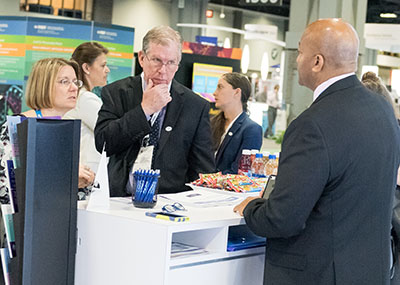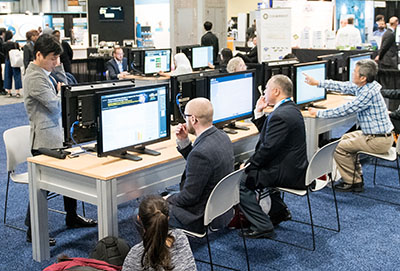
A new organizational structure and innovative elements won rave reviews.
By Devona Williams, Pharm.D.
AAPS President Christopher McCurdy, Ph.D., FAAPS, greeted 6,000 distinguished scientists, students, and supporters of pharmaceutical research and innovation at the opening plenary session of the first ever PharmSci 360 meeting held in Washington, D.C., November 4–7, 2018. McCurdy spoke with attendees about the renewed vision of AAPS with a new focus on building professional community and scientific innovation and enhancing career development opportunities. AAPS’ renewed, member-focused efforts have created more than 40 professional communities, including the newest addition of a student community.
PharmSci 360 featured several innovative elements. A new organizational structure offered 5 scientific tracks: Preclinical Development, Bioanalytics, Clinical Pharmacology, Manufacturing and Bioprocessing, and Formulation and Quality. End-to-end hot topic sessions provided daily symposia on the emerging topics of immuno-oncology and developing technologies that allow for rapid and cost-effective delivery of therapy to patients.
 AAPS welcomed Craig Venter, Ph.D., cofounder and chairman of Human Longevity, Inc. and founder of Celera Genomics, The Institute for Genomic Research, and the J. Craig Venter Institute, as an opening plenary speaker. His work focuses on tools to write the genetic code based on the understanding that “DNA is the software of life.” In addition, his life’s work has established the concept of “human essential genes” and an understanding that the essential genes in a human are not identical to essential genes in mice or even human genes isolated in tissue culture. Nearly two decades after the first genome sequence, the work he has pioneered is having a huge impact on human disease and drug discovery.
AAPS welcomed Craig Venter, Ph.D., cofounder and chairman of Human Longevity, Inc. and founder of Celera Genomics, The Institute for Genomic Research, and the J. Craig Venter Institute, as an opening plenary speaker. His work focuses on tools to write the genetic code based on the understanding that “DNA is the software of life.” In addition, his life’s work has established the concept of “human essential genes” and an understanding that the essential genes in a human are not identical to essential genes in mice or even human genes isolated in tissue culture. Nearly two decades after the first genome sequence, the work he has pioneered is having a huge impact on human disease and drug discovery.
His words of caution regarding genome technologies were about access and unexpected effects. As genome technologies become less expensive and more easily available, the public will have increased access to genetic information; however, what is most accessible is often incomplete and misleading. The risks of this technology lie in the realization that changing one thing can change everything, as modifications in one area lead to off-target effects that may produce unfavorable results.
He shared parting words of advice on overcoming challenges that he learned from a previous mentor, “The No. 1 failing of scientists is to talk themselves out of doing the experiment.”
Rapid Fire Sessions
Rapid Fire sessions were a popular new feature. Each day, all the scientific tracks had two hours of 10-minute presentations of relevant, innovative research findings. Insights gained from the research presented have potential for direct patient care advances, ranging from preventing preterm labor in highest risk patients to regulatory advancements by epidemiology teams at the Food and Drug Administration (FDA).
 The research team at Virginia Commonwealth University College of Pharmacy presented work on Vaginal Microbiome Metaproteome: Challenges and Opportunities for Pregnancy Complications and Pre-Term Birth. Infection-mediated changes in the vaginal microbiome impact pregnancy complications. The goal of their study was to identify biomarkers for preterm birth by highlighting proteins involved in the human host response. By gaining a better understanding of host-bacteria protein interactions, future microbiome-based therapies can be discovered, leading to a targeted decrease in maternal preterm labor.
The research team at Virginia Commonwealth University College of Pharmacy presented work on Vaginal Microbiome Metaproteome: Challenges and Opportunities for Pregnancy Complications and Pre-Term Birth. Infection-mediated changes in the vaginal microbiome impact pregnancy complications. The goal of their study was to identify biomarkers for preterm birth by highlighting proteins involved in the human host response. By gaining a better understanding of host-bacteria protein interactions, future microbiome-based therapies can be discovered, leading to a targeted decrease in maternal preterm labor.
Researchers from FDA presented study data on Estradiol quantitation methods to help regulate cardiac tissue and EKG abnormalities in women. FDA also presented rapid fire data on Model-Informed Drug Development (MIDD). MIDD uses an extensive risk-benefit evaluation format. MIDD currently has areas of focus in blood components, cellular and gene therapies, and therapeutic and preventative vaccines, to expedite review and approval of biologic agents and gene therapies.
Biomolecular Analyses in T-Cell Redirectors
The field of immuno-oncology has led to many exciting advancements in cancer therapy. Immuno-oncology capitalizes on manipulation of the host immune system to target malignant cells in the body. Bi-specific T-cell redirectors are a class of pharmaceuticals that bind to a specific antigen on targeted malignant cells and simultaneously bind to CD3 receptors on the surface of T-cells. The selective binding promotes targeted delivery of cytotoxic killing of malignant cells.
Presentations from Pfizer and Janssen Biotherapeutics highlighted some of the biomolecular challenges associated with bi-specific T-cell therapy. Ying Wang, Ph.D., from Pfizer Pharmaceuticals, presented the talk Bi-specific T-cell Redirectors PK/AD/Nab Strategy. It focused on strategies to overcome interference in assessment of pharmacokinetics/pharmacodynamics (PK/PD) target occupancy and associated cytokine release quantification. This study discussed the need to use a reagent that can specifically measure antidrug antibody interferences and soluble drug target interferences. Optimizing the specificity of the assay and reagent helps to address interference factors needed to properly understand PK and immunogenicity of new agents.
Wang gave an example of this work in treating multiple myeloma. The bi-specific targets in myeloma are T-cells and B-cell maturation antigen (BCMA). BCMA is a target in myeloma due to its function in proliferation, maturation, differentiation, and survival of plasma cells. They successfully validated an assay to separate supernatant from BCMA to evaluate the PK and immunogenicity of bi-specific T-cell therapy in myeloma.
A second perspective on this topic was presented by Adrienne Clements-Egan of Janssen Biotherapeutics, who presented Bi-specific T-cells Redirectors: Receptor Occupancy Strategy. Of the many CD3 T-cell redirectors in development, the agents have varied affinity for binding target receptors. Receptor occupancy (RO) is one of many elements that may be used in preclinical drug testing. RO may be initiated with in vitro assessments and function as a prerequisite to human PK/PD as a tool to influence dose escalation strategies. Through the course of her talk, she introduced another tool that can enhance the information gained from RO assays. She discussed the benefits of combining RO with soluble target engagement (STE) assays in developing bi-specific T-cells.
 RO of CD3 redirectors is not frequently evaluated in the literature. Some influencing factors are the fact that toxicity of biologic-based therapies is often due to exaggerated pharmacology of the agent and its effects on the immune system. Also, postinfusion T-cell marginalization, causing a decrease in the T-cell population following dose administration, would alter RO detection. In addition, if there is robust target cell depletion of T-cells, then measurement of RO is not needed. She also discussed a limiting factor to using
RO of CD3 redirectors is not frequently evaluated in the literature. Some influencing factors are the fact that toxicity of biologic-based therapies is often due to exaggerated pharmacology of the agent and its effects on the immune system. Also, postinfusion T-cell marginalization, causing a decrease in the T-cell population following dose administration, would alter RO detection. In addition, if there is robust target cell depletion of T-cells, then measurement of RO is not needed. She also discussed a limiting factor to using
STE alone, which applies to situations when the baseline levels of the soluble target are already low.
She explained the benefits of a complimentary RO and STE analysis approach. This method allows for understanding of both drug and target engagement, and the application in both healthy and diseased populations. RO and target engagement are a prerequisite for efficacy, which help with translational modeling and facilitate a more focused selection of first-in-human dose. The value of this technique has great impact on PK/PD modeling harnessing knowledge of RO T-cell activation and STE impact on dose and drug mechanism of action. Clements-Egan said, “Overall this is the PK/PD modeling of the future for CD3 bi-specific T-cell therapies.”
NMR Drug Characterization
The Formulation and Quality track featured a presentation by Joe Lubach, Ph.D., from the Small Molecule Sciences Department of Genentech. His presentation, Current Technical Challenges of High-Res Characterization of Drug Products and Insights of Impacts of Molecular Information on Drug Development, discussed emerging methodology for characterization of solid-state pharmaceuticals.
Solid-state pharmaceutical characterization involves understanding of structure, order, and dynamics of drug excipients and active pharmaceutical ingredients (API). Many analytic methods exist for characterization, such as particle size distribution, dynamic vapor sorption, and differential scanning calorimetry. There are inherent challenges in differentiation of API and excipients due to drug load dependence and signals from excipients overlapping with those of the API. Modern methods of powder X-ray diffraction, raman spectroscopy, and solid state nuclear magnetic resonance (NMR) can overcome many of these challenges. Lubach focused on advantages and applications of NMR on drug characterization by walking the audience through three case studies on drug product characterization using NMR.
 The first case study used 19F quantitation of amorphous material in an API product. 19F does not require pure reference samples or standard curve preparation, but it must account for spin-lattice relaxation and chemical shift anisotropy. 19F offers high sensitivity with no excipient interference, which makes it an ideal method for use in solid state drug product characterization.
The first case study used 19F quantitation of amorphous material in an API product. 19F does not require pure reference samples or standard curve preparation, but it must account for spin-lattice relaxation and chemical shift anisotropy. 19F offers high sensitivity with no excipient interference, which makes it an ideal method for use in solid state drug product characterization.
A second case focused on drug-polymer interactions, using indomethacin and Eudragit E (EE) as an example. 15N solid-state NMR was used to measure changes in local structure and protonation, while relaxation time measurement was used to determine miscibility of indomethacin with EE. 15N solid-state NMR showed changes in protonation of nitrogen as a function of low to high drug load, while relaxation dynamics gave information about the heterogenicity of phases in the amorphous solid dispersion.
The last case study examined implications of water sorption and using NMR to map the water content in a formulation. Dynamic vapor sorption water uptake curves measured water uptake potential. Lubach discussed the correlation between solid-state NMR and relaxation times to select excipients that uptake water and sequester the API from the impact of water sorption. The multiple utilities of NMR help with development and understanding of solid dosage forms with maximal API stability.
Chemistry and Manufacture Considerations of CAR T-cells
Historical standard modalities to treat cancer are composed of combinations of surgery, chemotherapy, and radiation. This nontargeted treatment approach poses significant toxicity to the patient and to healthy host tissues. Recent discoveries of molecular mutations and aberrations have led to targeted therapies that focus on disease-specific abnormalities in cancer treatment. The next generation of oncology therapy uses immunotherapy by harnessing the power of the patient’s immune system as a method to target cancer.
Chimeric antigen receptor (CAR) T-cell therapy uses adaptive cell transfer to collect cells and modify the cells as immunotherapy. The cells are engineered to target a specific antigen-binding protein and T-cells with an activating function, both in a single receptor. Current CAR T-cell therapies are autologous in nature, re-infusing cells into a patient after laboratory expansion. Marianna Sabatino, M.D., vice president of cell product sciences at Arcellx presented CMC [Chemistry, Manufacturing, and Controls] Considerations for the Development of Early Phase CAR-T Cell Programs. She discussed the evolution beyond current CAR T treatment toward third and fourth generation therapies in the next few years.
 She focused on challenges of CAR T-cell therapies that have origins in academic medical centers that are now expanding to production by commercial entities. One of the challenges is in the time table from apheresis to arrival of cells at the manufacturing site. In an academic setting, this transfer process is completed in less than one day; however, in a commercial process, the isolated tissue must be shipped to a laboratory for cell expansion. A similar difference exists after cellular expansion during the transfer of cells from manufacturing site to patient bedside. In this phase of the process, the complexity is not a clinical issue, but a product-related issue dependent on shipping and delivery logistics.
She focused on challenges of CAR T-cell therapies that have origins in academic medical centers that are now expanding to production by commercial entities. One of the challenges is in the time table from apheresis to arrival of cells at the manufacturing site. In an academic setting, this transfer process is completed in less than one day; however, in a commercial process, the isolated tissue must be shipped to a laboratory for cell expansion. A similar difference exists after cellular expansion during the transfer of cells from manufacturing site to patient bedside. In this phase of the process, the complexity is not a clinical issue, but a product-related issue dependent on shipping and delivery logistics.
In addition to logistical production matters, differences in the cell product must be considered also. The clinical effects of the variation of the infused product are not completely understood. CAR T products from academic centers are based on infusion of fresh product, while cells shipped from a commercial entity must be cryopreserved. The commercial manufacture process may include variability of raw materials and should encompass a potency assay process. As indications for use and approval of CAR T therapies continue to develop, the production cycle will continue to be standardized and improved.
In the following session, Kim Schultz, Ph.D., from the Division of Cellular and Gene Therapies at FDA, presented CMC Challenges of Gene and Gene-modified Cellular Therapy Products. The Center for Biologics Evaluation and Research at FDA is responsible for regulating cellular therapy products, human gene products, and devices related to cellular and gene therapies. Schultz discussed regulatory considerations for human gene therapy.
FDA strives to expedite review and approval of gene products that have the potential to change the treatment landscape for life-threatening diseases. Three components of the more flexible, expedited review process are Model-Informed Drug Development (MIDD), the Initial Targeted Engagement for Regulatory Advice (INTERACT) program, and the Regenerative Medicine Advanced Therapy (RMAT) designation.
Using MIDD for drug review allows for targeted interactions with experts in the field of modeling to evaluate emerging gene therapies. The INTERACT program is an informal meeting between the development team and FDA, available for initiation before preclinical testing begins, to assess regulatory considerations of gene therapies and associated devices. The goal of the INTERACT meeting is to proactively address and resolve elements that would be a regulatory barrier to the design, manufacture, and approval of gene-related therapies. RMAT is a new designation as a part of the 21st Century Cures Act. She explained the difference between an RMAT versus a breakthrough designation. A breakthrough designation is for a product that has demonstrated substantial improvement in an unmet medical need. The RMAT designation is for a product with preliminary evidence that shows the potential to address an unmet medical need.
These expedited pathways help get treatment to patients faster. However, there are regulatory challenges of these faster review processes. One challenge is that preliminary efficacy studies may be based on data from academia, and after drug approval, the large-scale manufacture process is often significantly different. Comparability studies are needed based on commercial manufacture processes. With rapid approvals, there is limited assay development to ensure the purity and potency for large-scale manufactured products. Assay development may be a time-consuming process, delaying information needed for product approval. Because critical quality attributes are not established, product characterization must be carried out very early in the development process. To help abate CMC challenges in gene therapies, she advised, “Product characterization must start early to continue the licensure life cycle. These are complex biologics.”
Targeted Delivery, Targeted Genetics
M. Jack Borrok, Ph.D., from MedImmune’s Antibody Discovery and Protein Engineering sector, presented
Emerging Modalities for Delivering Cancer Therapeutics. With the recent explosion in therapeutic immuno- oncology, biologics, and antibody therapies, great potential exists for drug entities that are “magic bullets,” that take specific aim at diseased tissue while leaving healthy tissue unaffected.
Traditional administration approaches often impact the target and impart off-target affects as well. Factors such as drug clearance, pharmacokinetics, organ penetration, and target binding sites all influence that ability to focus on disease target alone. Delivery challenges are impacted by a variety of variables. Low challenge target delivery is apparent for tissues that are highly vascular, have an easily accessible antigen, and agents where dose escalation is possible without limiting toxic effects. Reasons for a more substantial targeted-administration challenge are biologics that need to be directed to a more compartmentalized organ or tumor site for clinical efficacy or in situations where a biologic has a narrow therapeutic dosing window separating clinical effect and dose-limiting toxicity.
 Borrock shared several emerging modalities for targeted drug delivery involving intratumoral injection, thermogenesis, microparticles, and drug delivery polymers. Intratumoral injection is an option; however, this would not be feasible in cases of an inaccessible tumor site, as this would be an invasive procedure. Another disadvantage of intratumoral injection is the possibility of distant, systemic immunity effects. Medication formulations that utilize a thermogel may be used for localized delivery. He gave an example of Medi9197, which is a toll-like receptor (TLR) agonist being investigated for activity in solid tumors. Systemic administration of TLR agonists causes immune system stimulation and undesirable adverse effects, which is why intratumoral administration is needed. The in vitro kinetics of the thermogel show an initial high dose after administration, followed by slow sustained release of medication and enhanced tumor growth inhibition. Use of nanoparticles in delivery formulations allows for enhanced permeability and retention effect. This provides a higher level of drug delivery directly to the tumor as opposed to uptake by healthy organs. The difficulty with nanoparticles is the particle size. Nanoparticles >100nm are difficult to penetrate into tumor tissue. The future of targeted medicine will expand on the concepts of local delivery and controlled-release technology.
Borrock shared several emerging modalities for targeted drug delivery involving intratumoral injection, thermogenesis, microparticles, and drug delivery polymers. Intratumoral injection is an option; however, this would not be feasible in cases of an inaccessible tumor site, as this would be an invasive procedure. Another disadvantage of intratumoral injection is the possibility of distant, systemic immunity effects. Medication formulations that utilize a thermogel may be used for localized delivery. He gave an example of Medi9197, which is a toll-like receptor (TLR) agonist being investigated for activity in solid tumors. Systemic administration of TLR agonists causes immune system stimulation and undesirable adverse effects, which is why intratumoral administration is needed. The in vitro kinetics of the thermogel show an initial high dose after administration, followed by slow sustained release of medication and enhanced tumor growth inhibition. Use of nanoparticles in delivery formulations allows for enhanced permeability and retention effect. This provides a higher level of drug delivery directly to the tumor as opposed to uptake by healthy organs. The difficulty with nanoparticles is the particle size. Nanoparticles >100nm are difficult to penetrate into tumor tissue. The future of targeted medicine will expand on the concepts of local delivery and controlled-release technology.
Jurgen Borlak, Ph.D., of Hanover Medical School, in Hanover, Germany, spoke about using pharmacogenetics for patient selection and therapy choices in his presentation Emerging Pharmacogenetics Practices and Its Applications in Personalized Medicine. He discussed harnessing genetic information before initiating therapy to predict treatment-related outcomes and responses. Addressing differences in genotypes should be used for both efficacy and toxicity predictions. He warned, “Don’t confuse drug interactions with genetic polymorphisms of drug metabolic enzymes, even though the outcome can be the same.”
From the perspective of clinical trial design, genetic information can define the rationale for which patients are selected for a given treatment based on polymorphisms that determine differences in metabolism and elimination. He walked the audience through multiple examples of applied pharmacogenetics in both efficacy and toxicity implications. Borlak detailed the effects of genetic polymorphisms of vitamin K epoxide reductase in patients on warfarin therapy. A rapid assay is available to detect polymorphisms of CYP-450 2C9 and 2C19. Polymorphisms that lead to decreased carboxylation of vitamin K epoxide reductase will cause increased toxicity in the form of higher risk of bleeding in those patients. He also detailed examples of how genetic polymorphisms impact toxicity of antineoplastic agents, tuberculosis antibiotics, anti-epileptics, vasoactive medications, and immunosuppression for organ transplant. “Absorption, distribution, and metabolism have a tremendous output on drug safety.”
In conclusion, Borlak commented that understanding genetic and genomic information, “allows us to optimize drug selection and dose selection.” His recommendation for the future of medicine is “for every new baby that is born, use a blood sample to find genetic polymorphisms.” He appeals to regulatory agencies to embrace the concept and need for awareness of pharmacogenomic markers. His charge for the audience was, “I hope you are convinced this is not only exciting, but useful information.”
Devona Williams, Pharm.D., is a freelance medical writer in the Washington, D.C., area.